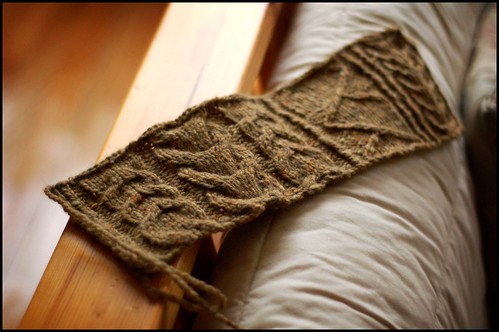
Pictured above: a washed, blocked, heavy-duty cable swatch. I love taking the extra care in the planning stages of an aran sweater. Because there are so many details involved (centering the panels just so, getting things to line up right for saddle shouldering and yoke shaping, the correct amount of filler sts, proper cable plumpness after blocking, etc.) I think a good couple of days of swatching and calculating is truly necessary. It makes for a positive knitting overall experience - hell, it's just good sense. Not to mention by the time you actually start the sweater, you feel like you could knit it with your eyes closed: you've already tested the charts and you've added, subtracted and shifted every panel around enough so that you know exactly how the thing is structured.

In a nutshell, here's my planning process, if you're interested (if not, just stare at the pictures and close this window - I totally understand. It's Monday morning after all).
If you have an idea of your desired gauge in stockinette (or happen to have a stockinette swatch already knit up somewhere, this is very good), note this number. Multiply this gauge by your target chest circumference to come up with the Key Number (as EZ would say), heretofore referred to as K.
Now, to more or less compensate for the change in gauge that cables will inevitably bring, multiply K by 1.1 (adding 10% of K to the total number of stitches. If you like plumper cables, add 15%) If your math renders a number with decimals, round up. You should now have a semi-accurate working number to start planning your sweater. For example, at this point in the equation, I projected 205 total body stitches.
Chart out your design. Using your total number and your chosen cable panels, plan your pattern, placing the motifs around the body as you prefer. Add up the total number of stitches that the main cables will consume and subtract from K - this will give you a 'remainder' number with which you can allocate to "fillers" (purl stitches between cables, or my preferred filler combo: p, ktbl, p, ktbl, p) A 3 st filler or a 5 st filler between your panels can cleanly and evenly use up your 'remainder' quite nicely.
Swatch. Cast on at least 30% of your total body stitches (I swatched on 70 stitches) and try to use one instance of each cable panel represented in the sweater. This will give you a pretty decent representation of the finished work (see above). I like to work each cable over at least 4-5 vertical repeats before binding off.
Wash and block your swatch. Do it. You'll be so happy you did. I try to wash my swatches on even the most basic sweaters, but for cables this is imperative. When working with wool, the blocking can drastically change the appearance of your cables: if you like them fat and plump, you won't need to stretch the fabric very much when pinning. If you prefer them flatter and less bombastic, you can squeak another inch or two out of your swatch when blocking. I prefer my cables to figure somewhere in the middle.
When your swatch is dry, unpin it (it might shrink a quarter inch or so) and measure the entire length. Divide this by the number of stitches cast on for the swatch and get your actual gauge. Does this match the gauge you had predicted earlier? It should resemble it fairly closely. Mine was a couple of tenths of a stitch off, so I plugged that number into my original sweater plan and needed to do a few final (very minor) readjustments. I changed my total number (K) from 205 to 210 and made up for these extra stitches in the side panels (under the arms to be super sly).
If you're still alive (you deserve a badge for patience) - start knitting! At this point, I could barely control myself, but it was utterly satisfying to see the real thing working up after all this fluff. And the sweater is flying - I'll show you an update later this week.
A note for the worrisome: keep your swatch nearby. When you get a few inches into your sweater, your intuitive knitting alarm will start going crazy. The sweater will seem MUCH too small. Just clutch your swatch close to your heart and have faith - remember how much length was gained after washing. As long as you abide by all the numbers, blocking should be your sweet salvation in the end. (I admit to succumbing to these fears about every 6 rows. And yes I've stretched the actual sweater over my swatch multiple times to make sure I'm not going to be a very disappointed knitter in the end).
P.S. This swatch is for the Elizabeth Zimmermann/Meg Swansen Saddle Shoulder Aran Cardigan from Wool Gathering #63. I've had this one tempting me for way too long.


